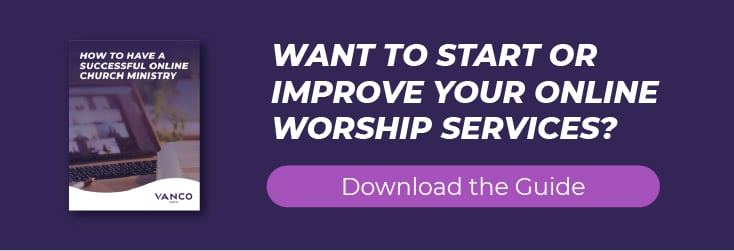
The scope and complexity of church leadership roles are evolving as demographic and social trends continue to affect traditional on-person church interactions. To keep up with the changing digital landscape of churches today, leadership training for church leaders is vital. While leadership training programs should always include communication, stewardship and pastoral skills, new leadership concepts now include knowledge of digital tools and how to use them to engage current church members and reach out to new ones. Keep reading for an overview of how church leaders can embrace technology to enhance the relevance and growth of their churches in our modern digital age.
Table of Contents
- Evolution of Church Leadership in the Digital Era
- Digital Transformation in Church Leadership
- Key Strategies for Effective Church Leadership
- The Role of Technology in Modern Church Leadership
- Challenges and Opportunities in Digital Ministry
- FAQs
Evolution of Church Leadership in the Digital Era
Today, digital growth for faith-based organizations is more important than ever. Building digital leadership skills — for both churches and church leaders — is a crucial part of ensuring the future of faith-based organizations just like yours. As trends like globalization and cloud-based services grow, churches must adapt accordingly to maintain their connections with current audiences and draw in new members.
One of the best ways to accomplish this is by leveraging digital tools that enrich the experience of your members and meet their current needs. Some of the most common digital tools that are used by faith-based organizations are:
- Online giving pages
- Mobile church apps
- Event ticketing
- Text-to-give
- Livestreaming options
- Credit card swipe readers
Digital technologies like these above offer practical solutions to many churches’ most common needs. They help to streamline actions such as how your members tithe, and allow you to better connect with the people in your congregation.
Here are some of the main perks of using digital technology solutions at your faith-based organization.
1. Increased Convenience
One of the most common reasons churches switch to digital solutions is the added convenience their features offer. Technology such as mobile church apps can save church staff members time and resources by automating common tasks and improving organization.
2. Centralized Information
Another huge advantage of church technology is that it can centralize important information. For example, church apps can store important data like member directories, sermon notes and event details. Storing everything on one centralized platform makes it much easier to stay organized and locate what you’re looking for, whether you’re a leader or a congregant.
3. Increased Giving
Church technology can also go a long way toward helping your faith organization reach its giving goals. When members have options besides in-person giving (such as on-the-go tithing or automated donations), they’re much more likely to give.
Digital technology like the options offered by Vanco Payments can help your organization transform its digital social presence, fundraising and engagement with members. Click here to get a demo and see what our tools can do for your church!
Digital Transformation in Church Leadership

Digital transformation can be complex and intimidating for many churches and congregations, so it requires strong and effective church leadership. Digital tools can offer huge benefits to churches, expanding their reach and drawing in new congregation members. They can be used to share information, connect with parishioners and even allow them to give on the go. However, it can sometimes be a challenge to implement these tools. For these and many other reasons, church leaders and their leadership teams must often champion the implementation and use of digital tools.
Many churches are slow or even unwilling to adapt to digital technology solutions. They may find them cost prohibitive, or encounter confusion about digital technology and a general lack of knowledge about the available options. In addition, it can sometimes also be difficult to convince reluctant members to use these technologies. Certain demographics, such as aging generations, may need to become more familiar with digital technology such as mobile apps, or may have concerns about the security of online giving.
The best way to transition to digital technology at your faith-based organization is to look for tools that meet your specific needs. For example, if your church only has in-person giving options (such as the weekly offering at Sunday services), providing on-the-go digital tithing options can help encourage more giving and help organize and streamline your church’s finances. Another example is if your church hosts a lot of public events or groups, digital event ticketing and livestreaming options can help lighten the logistical load of planning these activities and reaching as many people as possible.
The Truth About In-Person Attendance
In-person church attendance is declining, which is a common concern for many faith-based organizations. As a church leader, you may be wondering how to approach this trend. In 2022, the average in-person attendance was 506 people among the nearly 200 churches that participated in the survey. These churches ranged in size from a small group of under 100 people to over 7,500 people. However, the churches surveyed also garnered over 2,000 weekly views of their online services and sermons.
Some of the main reasons why many people opt out of in-person services include:
- Concerns about COVID-19
- Illnesses or chronic conditions that make leaving the house difficult
- Scheduling conflicts, such as work
- Lack of child care
How Online Engagement Can Help
In 2022, churches’ average in-person attendance dropped by 34% compared to the previous year. On the other hand, the average number of online weekly service views has more than tripled since 2021, with churches reporting an average of 2,173 service views per week compared to 712 service views in 2021. Regardless of the size of your church, online tools can help increase both accessibility and donations.
Many people have a strong desire to attend church but cannot attend in-person services regularly due to various responsibilities and personal circumstances. Online attendance options greatly increase the accessibility of church for these people, because they no longer have to leave their homes. Instead, attendees can view livestreaming options or prerecorded messages at their convenience. You can also use digital tools to expand your prayer ministry offerings.
Many of those who cannot attend services regularly may also struggle with feeling disconnected from their faith organizations. A lack of social options or easy ways to connect with other members can be prohibitive for many folks — and may lead to them to find new churches or not attend at all. Mobile church apps connect members with the organization as a whole, which is crucial for maintaining your attendance and tithing goals.
Don’t ignore the potential of email outreach and digital newsletters either. In 2022, the number of people who signed up to receive digital communications increased by 26%! Digital communications that go directly to recipients can be an excellent way to draw in members who haven’t participated as much recently. An interesting title, eye-catching graphics and a strong call to action (CTA) are all part of crafting engaging digital communications.
Key Strategies for Effective Church Leadership Training

Encouraging church engagement requires effective church leadership skills and a flexible and positive leadership style. Church leaders must be able to recognize what their members need and want and find practical ways to meet those needs. At the same time, church leaders must balance these needs with the overall goals and mission of their churches. They must consider both long-term and short-term factors to advance the overall missions of their faith communities.
Digital tools are some of the most effective tools that pastors and other faith leaders can use to engage with church members. To learn any new tool or skill, church leadership development can help leaders and leadership teams explore ways to make digital transformation as easy as possible. Let’s look at some principles of church leadership that can accomplish this.
1. Embrace Digital Tools and Platforms
First, church leaders should demonstrate true leadership skills by embracing digital tools and technology platforms. These tools can expand your overall reach and raise engagement levels and are extremely useful for helping keep church logistics more organized.
As a faith organization, ensuring logistical and financial organization must always remain a top priority. A sustainable organization is much better equipped to face the future and meet ongoing challenges in their ministry. Digital tools can also free up your workflow, allowing your ministry team to focus on what matters — your congregation.
2. Integrate Social Media and Online Communication
Another crucial church leadership training tool that leaders should use is social media. Integrating social media and online communication into your church’s outreach can greatly expand your potential reach, especially locally. For example, creating an Instagram account for your church and including local hashtags and locations on your posts can help more members of your community see your posts. Creating digital event pages (such as on Facebook) allows people to share your events and related details with other people who might be interested.
Younger generations such as Gen Z are also much more likely to use social media compared to aging generations. Using social media platforms that are popular with these demographics can help make them more reachable.
3. Create Engaging Online Content Strategies for Outreach
While creating social media platforms is an important part of crafting your church’s digital presence, having a strategy for how you will use them is just as crucial. Some tips for making more engaging digital content include:
- Be aware of your audience’s wants and needs.
- Create a content schedule or posting schedule.
- Include a strong CTA.
- Use colorful and engaging graphics, photos and video shorts.
- Include relevant keywords and local information.
- Create interactive content.
- Regularly reevaluate your social media strategy and make appropriate adjustments.
4. Develop a Clear Digital Ministry Strategy
Finally, developing a clear digital ministry strategy is another leadership concept that can smooth your digital transition. Your ministry strategy provides the guiding framework for how you will manage your digital presence, so don’t neglect this aspect of leadership. Developing your digital ministry strategy should involve:
- Deciding what social media platforms you’re going to use and why
- Creating a website and social media profiles
- Finalizing your digital engagement strategy
- Defining your target audience
- Including interactive content like surveys and polls
- Periodically reassessing your strategy
The Role of Technology in Modern Church Leadership

Technology plays an especially important role in the world of modern church leadership. Not only is it necessary to adapt to digital trends for church growth, but technology can also be leveraged for long-term goals like community building and boosting engagement.
Churches must not ignore the wide potential that digital technology leadership offers. Church leaders must find new ways to both encourage their audiences to engage digitally and meet them where they are. In many cases, providing incentives or positive reasons to engage digitally can be quite effective. For example, if certain people in your church (such as aging demographics) are unwilling or uncertain about using social media, emphasizing the positive benefits can encourage them to become more engaged. Providing digital mentorship or a center for church-based training to those in your church who may be less familiar with technology is another great way to incorporate more digital elements into your faith organization and encourage members to use them.
Challenges and Opportunities in Digital Ministry

As with any form of ministry, there will always be certain challenges to address. Two of the most common challenges are:
1. Addressing Staffing Needs for Digital Roles
Did you know that on average, churches employ one full-time staff member for every 42 attendees? As churches continue to expand their digital offerings and presence in the coming years, they must also find ways to address the staffing demands of these roles. While many churches are eager to hire new staff for in-person ministries, this tends not to be the case when it comes to digital ministries.
2. Overcoming Barriers to Effective Digital Engagement
Another common challenge is overcoming the barriers between attendees and effective engagement. Increasing accessibility is critical — such as providing subtitles and sign language for those who may have physical impairments. Multiple service times and engaging social media content are also necessary to draw in congregants.
FAQs
Finally, let’s answer some of the most common questions related to digital technology and church leadership training.
1. How can church leadership adapt to digital trends?
The best way to take advantage of digital trends is to get involved! Church leaders must not be afraid of using technology but see it as the valuable tool it is. Having a clear vision for your church and knowing your members’ needs must be top priority. At the same time, consider different church leadership training ideas to ensure church leaders stay on top of the digital landscape and can help church members adopt new tools.
2. What are the benefits of integrating digital strategies and training in church leadership?
Integrating technology into your church leadership training can also help save your team time and resources. With digital technology, you’ll have more time to focus on the people in your church and ways to best serve them.
3. How can digital tools enhance church community engagement?
Digital tools are especially useful for raising awareness of your church! After all, it’s hard to draw in new attendees if no one knows you’re there. Social media and digital outreach can help you greatly expand your reach.
4. How to use AI to improve leadership?
As a church leader, plenty of things fall onto your plate, and even with a devoted set of volunteers to help, it can be challenging to do everything you need to grow your church. Fortunately, there are free tools and processes that can save plenty of time and help your church expand its capabilities. In the video below, we outline free tools and processes to help.
5. What are some effective digital ministry models for churches?
Vanco Payments provides a wide array of digital ministry tools and advice. Check out our blog for other helpful content geared toward digital church leadership.
6. How has the pandemic impacted church leadership strategies?
There’s no denying that the pandemic hurt physical church attendance. However, with digital tools, churches can discover new ways of engaging with their audiences and creating a positive impact.
Get Everything Church Leaders Must Know in One Free Guide
Get the tested church leadership strategies and techniques used by top ministries to build healthy and growing congregations. Download our free eBook to learn…
- What to avoid.
- How to set SMART goals.
- Leadership model structures to inspire your church leadership strategy.
- How to recruit volunteers and delegate.
- How to handle challenging situations such as disgruntled church members or staff.
- How to be a good financial steward for your church.
- And more!
















